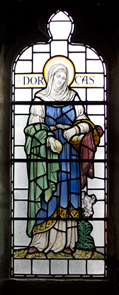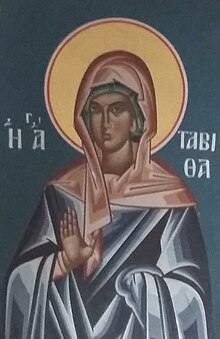Dorcas
Dorcas (Greek: Δορκάς, Dorkás; Aramaic: טביתא Ṭabītā) was a disciple who lived in Joppa, referenced in the Acts of the Apostles (9:36–42) in the New Testament.[1] Her name in the Textus Receptus is "Ταβιθά" (Tabitha).[2]
Biblical accounts[edit]
Acts recounts that when she died, she was mourned by "all the widows...crying and showing (Peter) the robes and other clothing that she had made while she was still with them" (Acts 9:39).[1] The Greek construct used in this passage indicates that the widows were the recipients of her charity,[3] but she may also have been a widow herself.[4] It is likely that she was a woman of some means, given her ability to help the poor.[5] The disciples present called upon Peter, who came from nearby Lydda to the place where her body was being laid out for burial, and raised her from the dead.[5]
This narrative concerning Tabitha/Dorcas indicates her prominence in the community at Joppa.[5][6] This might also be indicated by the fact that Peter took the trouble to come to her from a neighbouring city, when requested by the community members.
Name[edit]
The name Dorcas is a Greek translation of the Aramaic name Tabitha, meaning "gazelle".[6][7] One species of gazelle is now known as the dorcas gazelle.[8]
In Christian tradition[edit]


Basil of Caesarea refers to Dorcas as an example in her Morals (rule 74): "That a widow who enjoys sufficiently robust health should spend her life in works of zeal and solicitude, keeping in mind the words of the Apostle and the example of Dorcas."[9] She is also commemorated in poems by Robert Herrick ("The Widows' Tears: Or, Dirge of Dorcas") and George MacDonald ("Dorcas").
Feast[edit]
Dorcas, along with Lydia of Thyatira and Phoebe, is honored with a feast day on the liturgical calendar of the Episcopal Church in the United States of America on January 27.[10] The Evangelical Lutheran Church in America also places their joint commemoration on January 27, immediately after the male missionaries remembered after the feast of St. Paul's Conversion, but the Lutheran Church Missouri Synod (LCMS) commemorates these three faithful women on October 25.[10][11] The Catholic Church commemorates Dorcas (under the Aramaic version of her name, St Tabitha) on October 25,[12] the same date as the Eastern Church.[10] Dorcas societies, which provide clothing to the poor, are named after her.[6]
On October 25 the Eastern Orthodox Church celebrates Saint Tabitha the Widow, raised from the dead by the Apostle Peter.[13]
In art[edit]
Depictions of Dorcas in art can be found as early as the fourth century, and her raising is often included in Medieval and Renaissance illustrations of the life of Saint Peter.[14][15]
Dorcas' acts of charity are a common subject of stained glass church windows. She is represented in a window in the apse of Christ Church, Bath, on the south side of St Peter's Church, Caversham, in St. Andrew's Church, Cheddar, in the sacristy of Calvary Episcopal Church (Pittsburgh), in Llandaff Cathedral in Cardiff, in St Leonard's Church, Bridgnorth, in Castleton Parish Church in Derbyshire, on the north side of St. Nicholas' church in Castle Hedingham in Essex, in the Ladychapel of St Michael's Church in Mytholmroyd, West Yorkshire, in an oriel window at the Head Office of the Retail Trust in north London and in a window in St Andrew's Church in Moretonhampstead.
The Lady chapel of St Patrick's Cathedral, Dublin has a window of Dorcas with the legend: "Dorcas this woman was full of good works and almsdeeds". Christ Church, St. Joseph, Missouri, depicts her holding a blue cloth in a prominent nave window (1885) on the south side. Grace and Holy Trinity Episcopal Church in Richmond, Virginia has her in a window made in Germany around 1890.[16]
Dorcas and Cornelius are represented on the stained glass windows above the altar in the Emmanuel Anglican Church in Lawson, New South Wales. In the church of St. Lawrence, Weston under Penyard, Herefordshire, she is depicted with St. Paul in a pair of stained glass windows dedicated to the memory of Edward Burdett Hawkshaw, the Rector from 1854-1912, and his wife, Catherine (a photograph nearby in the church shows that his likeness is the face given to St. Paul, while Dorcas has the face of Mrs. Hawkshaw).
References[edit]
- ^ a b Syswerda, Jean E. (2002). Women of the Bible : 52 Bible studies for individuals and groups. Grand Rapids, Mich.: Zondervan. p. 214. ISBN 0310244927.
- ^ "Acts 9:36 (KJV)".
- ^ Bock, Darrell L. (2007). Acts (Baker Exegetical Commentary on the New Testament). Baker Books. p. 378. ISBN 1441200266.
- ^ Gangel, Kenneth O. (1998). Holman New Testament Commentary - Acts. B&H Publishing Group. p. 146. ISBN 0805402055.
- ^ a b c Witherington, Ben (1998). The Acts of the Apostles: A Socio-rhetorical Commentary. Wm. B. Eerdmans. pp. 331–332. ISBN 0802845010.
- ^ a b c Lockyer, Herbert (1967). All the women of the Bible. Grand Rapids: Zondervan. pp. 46–48. ISBN 0310281512.
- ^ "Strong's Greek: 1393. Δορκάς (Dorkas) -- "gazelle" (an animal with large bright eyes), Dorcas, a Christian woman". biblehub.com. Retrieved 2019-05-11.
- ^ Hildyard, Anne [ed.] (2001). Endangered wildlife and of the world. New York [u.a.]: Marshall Cavendish. p. 606. ISBN 0761471944.CS1 maint: extra text: authors list (link)
- ^ Basil, Saint (1999). Ascetical Works. CUA Press. p. 191. ISBN 0813211093.
- ^ a b c Pfatteicher, Philip H. (2008). The new book of festivals and commemorations : a proposed common calendar of saints. Minneapolis: Fortress Press. p. 683. ISBN 9780800621285.
- ^ Kinnaman, Scot A. (2010). Lutheranism 101. St. Louis: Concordia Publishing House. p. 278. ISBN 9780758625052.
- ^ Sheehan, Thomas W. (2001). Dictionary of Patron Saints' Names. Our Sunday Visitor Publishing. p. 268. ISBN 0879735392.
- ^ "Commemoration of St. Tabitha the Widow". Orthodox Church of America. Archived from the original on October 10, 2018. Retrieved Oct 7, 2018.
- ^ Ross, Leslie (1996). Medieval Art: A Topical Dictionary. Greenwood Publishing Group. p. 239. ISBN 0313293295.
- ^ Earls, Irene (1987). Renaissance Art: A Topical Dictionary. ABC-CLIO. p. 226. ISBN 0313293295.
- ^ "Grace & Holy Trinity Church: The Dorcas Window". Retrieved 2013-10-27.
External links[edit]
![]() Media related to Dorcas at Wikimedia Commons
Media related to Dorcas at Wikimedia Commons
